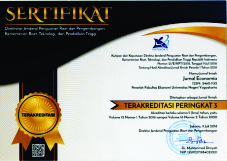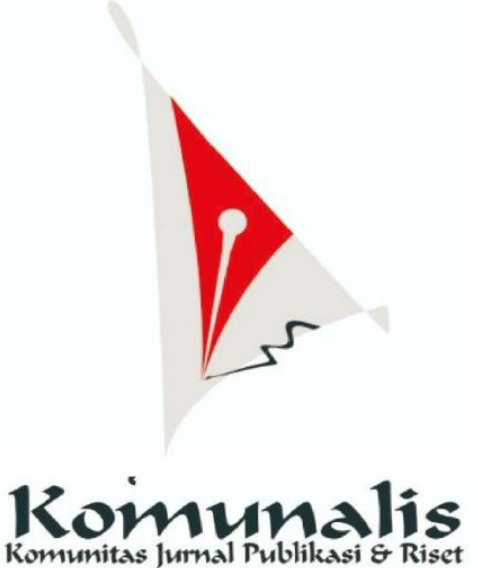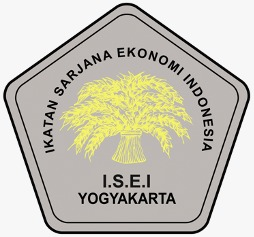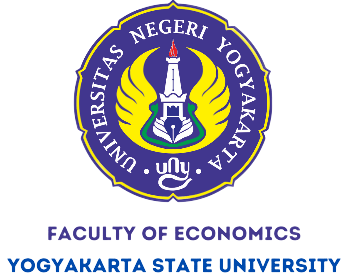Financial Literacy and Inclusion in Indonesia During the Crisis: A Content Analysis Approach
Downloads
This study aims to identify and describe the condition of financial literacy and inclusion in Indonesia during the covid-19 pandemic crisis (March 2, 2020 – August 31, 2022). The data used are news published in online news media, namely Kompas.id. The number of news articles used was 65. The analysis method used is content analysis. The result of this study’s analysis show that the main topic that is most discussed about financial literacy and inclusion in Indonesia is the poor condition of financial literacy and inclusion in Indonesia. The most discussed special topic about financial literacy is the community group that is the focus of financial literacy. Meanwhile, low financial literacy is the most discussed sub-topic. Efforts to increase financial inclusion are the topic with the highest frequency of discussion related to financial inclusion in Indonesia. The most discussed sub-topic related to financial inclusion is digital-based financial inclusion.
Downloads
Anshika, Singla, A., & Mallik, G. (2021). Determinants of financial literacy: Empirical evidence from micro and small enterprises in India. Asia Pacific Management Review, 26(4), 248–255. https://doi.org/10.1016/j.apmrv.2021.03.001
APJII. (2022). Profil Internet Indonesia 2022.
Badan Kebijakan Fiskal. (2021). Cara indonesia menangani pandemi covid-19 dan dampaknya terhadap perekonomian. Gramedia Pustaka Utama.
Badan Kebijakan Fiskal. (2022). Inklusi keuangan untuk keadilan dan kemakmuran rakyat Indonesia (S. Ika, D. Hendratto, & L. Z. Nasution (eds.)). Gramedia Pustaka Utama.
Bank Indonesia. (2020). Krisis kemanusiaan COVID-19 dan implikasinya pada tatanan perekonomian global. 2020, 20.
Brillianti, F., & Kautsar, A. (2020). Apakah literasi keuangan memengaruhi kesejahteraan rumah tangga di Indonesia?. Kajian Ekonomi Dan Keuangan, 4(2), 103–115. https://doi.org/10.31685/kek.v4i2.541
Eriyanto. (2011). Analisis isi: Untuk penelitian ilmu komunikasi dan ilmu-ilmu sosial lainnya (Edisi Pert). Kencana.
Gandasari, D., & Dwidienawati, D. (2020). Content analysis of social and economic issues in Indonesia during the COVID-19 pandemic. Heliyon, 6(11), e05599. https://doi.org/10.1016/j.heliyon.2020.e05599
Geng, Z., & He, G. (2021). Digital financial inclusion and sustainable employment: Evidence from countries along the belt and road. Borsa Istanbul Review, 21(3), 307–316. https://doi.org/10.1016/j.bir.2021.04.004
Global Partnership for Financial Inclusian. (2022). G20 Financial Inclusion Indicators. GPFI. https://datatopics.worldbank.org/g20fidata/
Green-Saraisky, N. (2015). Analyzing public discourse: Using media content analysis to understand the policy process nancy green saraisky. Current Issues in Comparative Education, 18(1), 26–41.
Hasan, M., Le, T., & Hoque, A. (2021). How does financial literacy impact on inclusive finance? Financial Innovation, 7(1). https://doi.org/10.1186/s40854-021-00259-9
Hidayatinnisa, N., Fauziah, Trivena, S. M., & Aini, Y. N. (2021). The effect of financial literacy and financial inclusion on economic growth in Indonesia. Jurnal Bisnis, Manajemen Dan Perbankan, 7(2), 339–359. https://doi.org/10.30596/ijbe.v1i1.3442
Kawamura, T., Mori, T., Motonishi, T., & Ogawa, K. (2021). Is financial literacy dangerous? Financial literacy, behavioral factors, and financial choices of households. Journal of the Japanese and International Economies, 60. https://doi.org/https://doi.org/10.1016/j.jjie.2021.101131
Kompas.com. (2022). Asal Usul Covid-19, Pasar Wuhan Disebut Pusat Awal Pandemi. https://www.kompas.com/tren/read/2022/03/07/164348965/asal-usul-covid-19-pasar-wuhan-disebut-pusat-awal-pandemi?page=all
Li, J., Li, Q., & Wei, X. (2020). Financial literacy, household portfolio choice and investment return. In Pacific Basin Finance Journal (Vol. 62). https://doi.org/10.1016/j.pacfin.2020.101370
Martono, N. (2019). Metode Penelitian Kuantitatif: Analisis Isi dan Data Sekunder (Edisi Revi). Rajagrafindo Persada.
Morgan, P. J., & Long, T. Q. (2020). Finacial literacy, finacial inclusion, and savings behavior in Laos. Journal of Asian Economics, 68. https://doi.org/https://doi.org/10.1016/j.asieco.2020.101197
OECD. (2016). OECD/INFE International Survey of Adult Financial Literacy Competencies.
OECD. (2020). Launch of the OECD/INFE 2020 International Survey of Adult Financial Literacy.
OJK. (2021). Strategi Nasional Literasi Keuangan Indonesia (SNLKI) 2021 - 2025.
Ozili, P. K. (2020). Theories of Financial Inclusion (pp. 1–23). SSRN. https://doi.org/https://dx.doi.org/10.2139/ssrn.3526548
Ozili, P. K. (2021). Financial inclusion: Globally important determinant. Financial Internet Quarterly, 17, 1–11.
Ozturk, I., & Ullah, S. (2022). Does digital financial inclusion matter for economic growth and environmental sustainability in OBRI economies? An empirical analysis. Resources, Conservation and Recycling, 185. https://doi.org/https://doi.org/10.1016/j.rescon rec.2022.106489
Reuters Institute. (2022). Reuters Institute Digital News Report 2022.
Rink, U., Walle, Y. M., & Klasen, S. (2021). The financial literacy gender gap and the role of culture. In Quarterly Review of Economics and Finance (Vol. 80, pp. 117–134). https://doi.org/10.1016/j.qref.2021.02.006
Romli, K. (2016). Komunikasi Massa. Grasindo.
Sekita, S., Kakkar, V., & Ogaki, M. (2022). Wealth, financial literacy and behavioral biases in Japan: The effects of various types of financial literacy. Journal of the Japanese and International Economies, 64(December 2021), 101190. https://doi.org/10.1016/j.jjie.2021.101190
Sinha, S. B., & Gupta, A. (2013). Financial inclusion and financial literacy : A comparative Study in their interrelation between selected urban and rural areas in the state of West Bengal. Journal of Economics and Finance, 67–72.
Tay, L.-Y., Tai, H.-T., & Tan, G.-S. (2022). Digital financial inclusion: A gateway to sustainable development. Heliyon, 8(6), e09766. https://doi.org/10.1016/j.heliyon.2022.e09766
Van Nguyen, H., Ha, G. H., Nguyen, D. N., Doan, A. H., & Phan, H. T. (2022). Understanding financial literacy and associated factors among adult population in a low-middle income country. Heliyon, 8(6), e09638. https://doi.org/10.1016/j.heliyon.2022.e09638
Wahyono, & Hutahayan, B. (2021). The relationships between market orientation, learning orientation, financial literacy, on the knowledge competence, innovation, and performance of small and medium textile industries in Java and Bali. Asia Pacific Management Review, 26(1), 39–46. https://doi.org/10.1016/j.apmrv.2020.07.001
Worldbank.org. (2022). Financial Inclusion. Www.Worldbank.Org. https://www.worldbank.org/en/topic/financialinclusion/overview
Wulansari, D. (2021). Media Massa dan Komunikasi (M. Sy (ed.)). Mutiara Aksara.
Younas, Z. I., Qureshi, A., & Al-Faryan, M. A. S. (2022). Financial inclusion, the shadow economy and economic growth in developing economies. Structural Change and Economic Dynamics. https://doi.org/https://doi.org/10.1016/j.strueco.2022.03.011
Yue, P., Korkmaz, A. G., Yin, Z., & Zhou, H. (2022). The rise of digital finance: Financial inclusion or debt trap? Finance Research Letters, 47(PA), 102604. https://doi.org/10.1016/j.frl.2021.102604
Copyright (c) 2025 Jurnal Economia

This work is licensed under a Creative Commons Attribution 4.0 International License.















